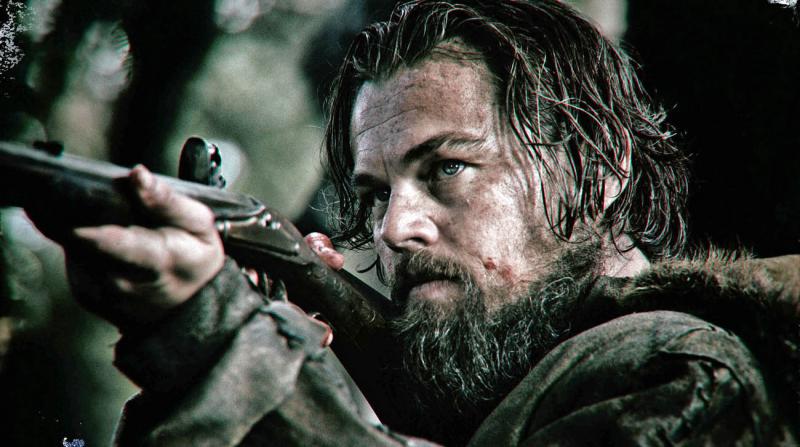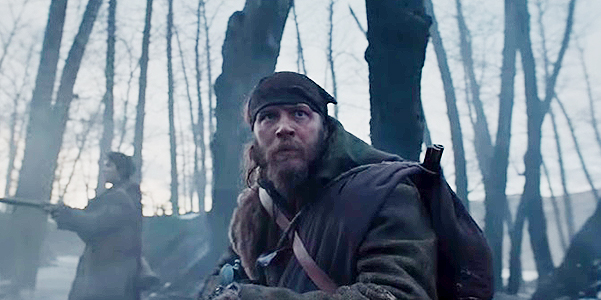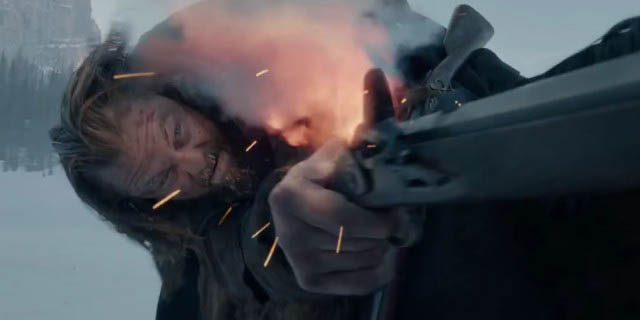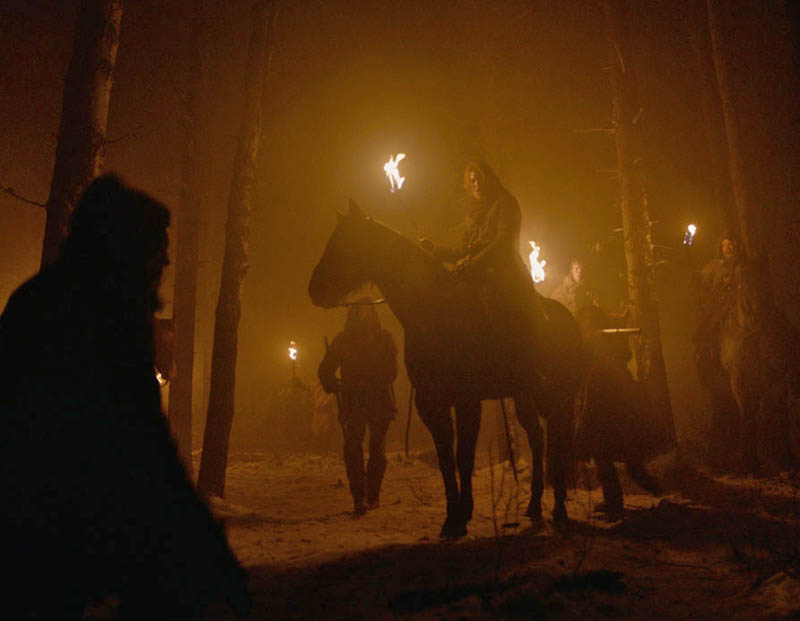The Revenant | reviews, news & interviews
The Revenant
The Revenant
Frontier survival epic achieves mythic force

Stories have abounded about the epic bouts of punishing location shooting that went into Alejandro González Iñárittu's frontier saga. Seeing the results on screen, you'd have to say that whatever suffering the cast and crew had to endure, it was worth it, and The Revenant's 12 Oscar nominations will be balm to their bruised and battered limbs.
One winner should surely be cinematographer Emmanuel Lubezki, going for his third successive gong (following Gravity and Iñárittu's Birdman). Shot mostly amid astounding scenery in the Canadian Rockies in British Columbia, The Revenant is as much about nature, the elements and the spirit of place as it is about the inextinguishable will to survive of its protagonist, Hugh Glass (Leonardo DiCaprio). Lubezki's stream of extraordinary images will linger long after you leave the cinema – mountains marching imperiously away over the horizon into the sunset, shadowy forest floors lit by flashes of sunlight through the trees, a fiery meteor falling over icy peaks, horsemen with flaming torches searching frozen woodlands by night, a ruined chapel in the wilderness adorned with painted iconography, Glass's dead wife hovering over him like a spirit-guide...
 With the pictures doing so much of the talking, Iñárittu and co-writer Mark L Smith were able to keep the narrative streamlined and clutter-free (it's based on a novel by Michael Punke). The Revenant is a tale of endurance and revenge, as frontier scout Glass, mauled by a bear in ghastly and protracted detail, is left for dead by his fur-trapping comrades. Determined he'll track down the man responsible, who also murdered his half-Pawnee Indian son, he drags himself back to civilisation, or what passed for it in South Dakota in the 1820s, through a series of barely-survivable challenges that make the Labours of Hercules look like I'm a Celebrity. The ferocious inner intensity DiCaprio brings to the role makes this his best work since The Departed, and we could forgive him for being righteously pissed off if the Academy get this one wrong.
With the pictures doing so much of the talking, Iñárittu and co-writer Mark L Smith were able to keep the narrative streamlined and clutter-free (it's based on a novel by Michael Punke). The Revenant is a tale of endurance and revenge, as frontier scout Glass, mauled by a bear in ghastly and protracted detail, is left for dead by his fur-trapping comrades. Determined he'll track down the man responsible, who also murdered his half-Pawnee Indian son, he drags himself back to civilisation, or what passed for it in South Dakota in the 1820s, through a series of barely-survivable challenges that make the Labours of Hercules look like I'm a Celebrity. The ferocious inner intensity DiCaprio brings to the role makes this his best work since The Departed, and we could forgive him for being righteously pissed off if the Academy get this one wrong.
Glass's despicable adversary is John Fitzgerald, towards his climactic encounter with whom the narrative arc inevitably bends. Fitzgerald is hardly a complex character, being defined solely by the lust to keep killing animals to acquire valuable pelts and sell them. Clearly this does not place him on the side of the natural spirits revered by the native Americans, and Fitzgerald embodies all the bad stuff you ever heard about how the West was won – he's brutal, cynical, murderous and unscrupulous. To his credit, Tom Hardy (pictured above), barely recognisable under thickets of facial hair and a hat covering a head once scalped by Indians) just about manages to make him human, with the aid of a country-hick mumble hailing from somewhere between Texas and Arkansas.
 Even before his great trial begins, Glass has survived an Indian attack which killed three-quarters of his party. This is the film's opening set-piece, and it has been shot with an immersive intensity that recalls the torrid battle sequences in Saving Private Ryan. Fluid camera work lays out the tactical picture, as mounted Arikara (or "Ree") warriors encircle the trappers on a river bank, while inside their perimeter sudden death arrives with the swoosh of an arrow or the thunk of a flying axe. The survivors' panicky scramble into the water and onto their boat amid a blizzard of arrows is the stuff of nightmares.
Even before his great trial begins, Glass has survived an Indian attack which killed three-quarters of his party. This is the film's opening set-piece, and it has been shot with an immersive intensity that recalls the torrid battle sequences in Saving Private Ryan. Fluid camera work lays out the tactical picture, as mounted Arikara (or "Ree") warriors encircle the trappers on a river bank, while inside their perimeter sudden death arrives with the swoosh of an arrow or the thunk of a flying axe. The survivors' panicky scramble into the water and onto their boat amid a blizzard of arrows is the stuff of nightmares.
But as much as it's a tale of elemental violence and barbarity, with the French and American pioneers and local tribes dispatching each other with a notable absence of squeamishness, it's also about the powerful motivating forces of love and loyalty.
 Glass is haunted by the murder of his Pawnee wife, killed by soldiers who annihilated their village, and would willingly die to protect their son Hawk (Forrest Goodluck). The chief of the pursuing Ree war party is searching for his daughter Powaqa, abducted by the French (shades of Ford's The Searchers in reverse). Even the bear that attacks Glass only does so to protect her cubs. Glass, versed in the ways of the tribes, strikes up his only friendship with a lone Indian, who has also seen his family wiped out.
Glass is haunted by the murder of his Pawnee wife, killed by soldiers who annihilated their village, and would willingly die to protect their son Hawk (Forrest Goodluck). The chief of the pursuing Ree war party is searching for his daughter Powaqa, abducted by the French (shades of Ford's The Searchers in reverse). Even the bear that attacks Glass only does so to protect her cubs. Glass, versed in the ways of the tribes, strikes up his only friendship with a lone Indian, who has also seen his family wiped out.
The film's meticulously-detailed sound picture intensifies the sense of a kind of natural intelligence watching over all this. Sounds of trees creaking in the wind, the rustle of leaves, twigs cracking underfoot and sounds of animals blend with Ryuichi Sakamoto's discreetly melancholy soundtrack, while the voice of Glass's late wife seems to hover in the metaphysical ether. For all its brutal physicality, Iñárittu and his team have given The Revenant the resonance of a myth which haunts with the spectral quality suggested by its title.
rating
Explore topics
Share this article
The future of Arts Journalism
You can stop theartsdesk.com closing!
We urgently need financing to survive. Our fundraising drive has thus far raised £49,000 but we need to reach £100,000 or we will be forced to close. Please contribute here: https://gofund.me/c3f6033d
And if you can forward this information to anyone who might assist, we’d be grateful.

Subscribe to theartsdesk.com
Thank you for continuing to read our work on theartsdesk.com. For unlimited access to every article in its entirety, including our archive of more than 15,000 pieces, we're asking for £5 per month or £40 per year. We feel it's a very good deal, and hope you do too.
To take a subscription now simply click here.
And if you're looking for that extra gift for a friend or family member, why not treat them to a theartsdesk.com gift subscription?
more Film
 Sorry, Baby review - the healing power of friendship in the aftermath of sexual assault
Eva Victor writes, directs and stars in their endearing debut feature
Sorry, Baby review - the healing power of friendship in the aftermath of sexual assault
Eva Victor writes, directs and stars in their endearing debut feature
 Blu-ray: Who Wants to Kill Jessie?
Fast-paced and visually inventive Czech comedy
Blu-ray: Who Wants to Kill Jessie?
Fast-paced and visually inventive Czech comedy
 Oslo Stories Trilogy: Love review - freed love
Gay cruising offers straight female lessons in a heady ode to urban connection
Oslo Stories Trilogy: Love review - freed love
Gay cruising offers straight female lessons in a heady ode to urban connection
 Beating Hearts review - kiss kiss, slam slam
Romance and clobberings in a so-so French melodrama
Beating Hearts review - kiss kiss, slam slam
Romance and clobberings in a so-so French melodrama
 Materialists review - a misfiring romcom or an undercooked satire?
Writer-director Celine Song's latest can't decide what kind of film it is
Materialists review - a misfiring romcom or an undercooked satire?
Writer-director Celine Song's latest can't decide what kind of film it is
 theartsdesk Q&A: actor Leonie Benesch on playing an overburdened nurse in the Swiss drama 'Late Shift'
The Guildhall-trained German star talks about the enormous pressures placed on nurses and her admiration for British films and TV
theartsdesk Q&A: actor Leonie Benesch on playing an overburdened nurse in the Swiss drama 'Late Shift'
The Guildhall-trained German star talks about the enormous pressures placed on nurses and her admiration for British films and TV
 Freakier Friday review - body-swapping gone ballistic
Lindsay Lohan and Jamie Lee Curtis's comedy sequel jumbles up more than their daughter-mother duo
Freakier Friday review - body-swapping gone ballistic
Lindsay Lohan and Jamie Lee Curtis's comedy sequel jumbles up more than their daughter-mother duo
 Eight Postcards from Utopia review - ads from the era when 1990s Romania embraced capitalism
Radu Jude's documentary is a mad montage of cheesy TV commercials
Eight Postcards from Utopia review - ads from the era when 1990s Romania embraced capitalism
Radu Jude's documentary is a mad montage of cheesy TV commercials
 The Kingdom review - coming of age as the body count rises
A teen belatedly bonds with her mysterious dad in an unflinching Corsican mob drama
The Kingdom review - coming of age as the body count rises
A teen belatedly bonds with her mysterious dad in an unflinching Corsican mob drama
 Weapons review - suffer the children
'Barbarian' follow-up hiply riffs on ancient fears
Weapons review - suffer the children
'Barbarian' follow-up hiply riffs on ancient fears
 theartsdesk Q&A: filmmaker Dag Johan Haugerud on sex, love, and confusion in the modern world
The writer-director discusses first-love agony and ecstasy in 'Dreams', the opening UK installment of his 'Oslo Stories' trilogy
theartsdesk Q&A: filmmaker Dag Johan Haugerud on sex, love, and confusion in the modern world
The writer-director discusses first-love agony and ecstasy in 'Dreams', the opening UK installment of his 'Oslo Stories' trilogy

Add comment